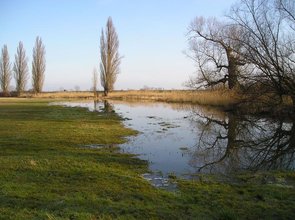Starting Point
In 1983 the inner dyke-system in the natural reserve "Kühkopf-Knoblochsaue" was demolished by two big floods in succession.
In consequence 300 ha of former arable land were changed into woods (150 ha) by natural succession and grasslands (150 ha) by means of controlled succession (just cutting the upcoming vegetation once a year).
Now, after more than 20 years and in spite of suitable ecological conditions on these new meadows there are:
- still a low number of species,
- only trivial and common species and virtually
- no rare floodplain-meadow species.
So, as
- the ecological site conditions are favourable and
- highly valuable species-rich floodplain meadows are to be found nearby (distances lower than 1 km) and
- the new meadows are - after the partly destruction of the dykes in 1983 - regularly flooded and
- the management of the new meadows aims at the development of floodplain-meadows.
Why have there literally no rare floodplain species established themselves after 30 years?
and
What are the limiting factors?
- Many of the target species do not build up a persisting soil seed-bank.
- Many of the target species are characterised by very small dispersal distances (usually less than 1 m per year).
- Seemingly no effective transfer of diaspores and/or propagules through regularly occurring floods, in spite of stands with target species nearby.
- Even if there is an input of diaspores it is difficult for new species to find a niche once a first vegetation layer has itself established.
- Old means of dispersal do not exist anymore in modern agricultural landscapes (as e.g. random dispersion through loss of seeds in course of haymaking/ transport, transfer with cattle ect.).
So, the limiting factors are on one hand a lack of effective dispersal of target species and on the second hand a lack of appropiate areas / time frames for target species to establish. In order to re-establish species-rich floodplain meadows relatively quickly, restoration measures have to be undertaken.
Aims
The aims of the restoration projects along the northern Upper Rhine are:
- The enlargement of highly rare species-rich floodplain meadows by restoration of ex-arable fields and, to a lesser degree, species-poor meadows.
- The testing of diaspore transfer with plant-material (green-hay transfer) as a restoration measure.
- The implementation of an non-intensive agricultural utilisation system which allows the farmers to gain a decent income and at the same time enables long-term maintenance of the meadows.
- Monitoring of the applied restoration measures as well as the assessment of ecology and population biology of flora and fauna in floodplain meadows.


